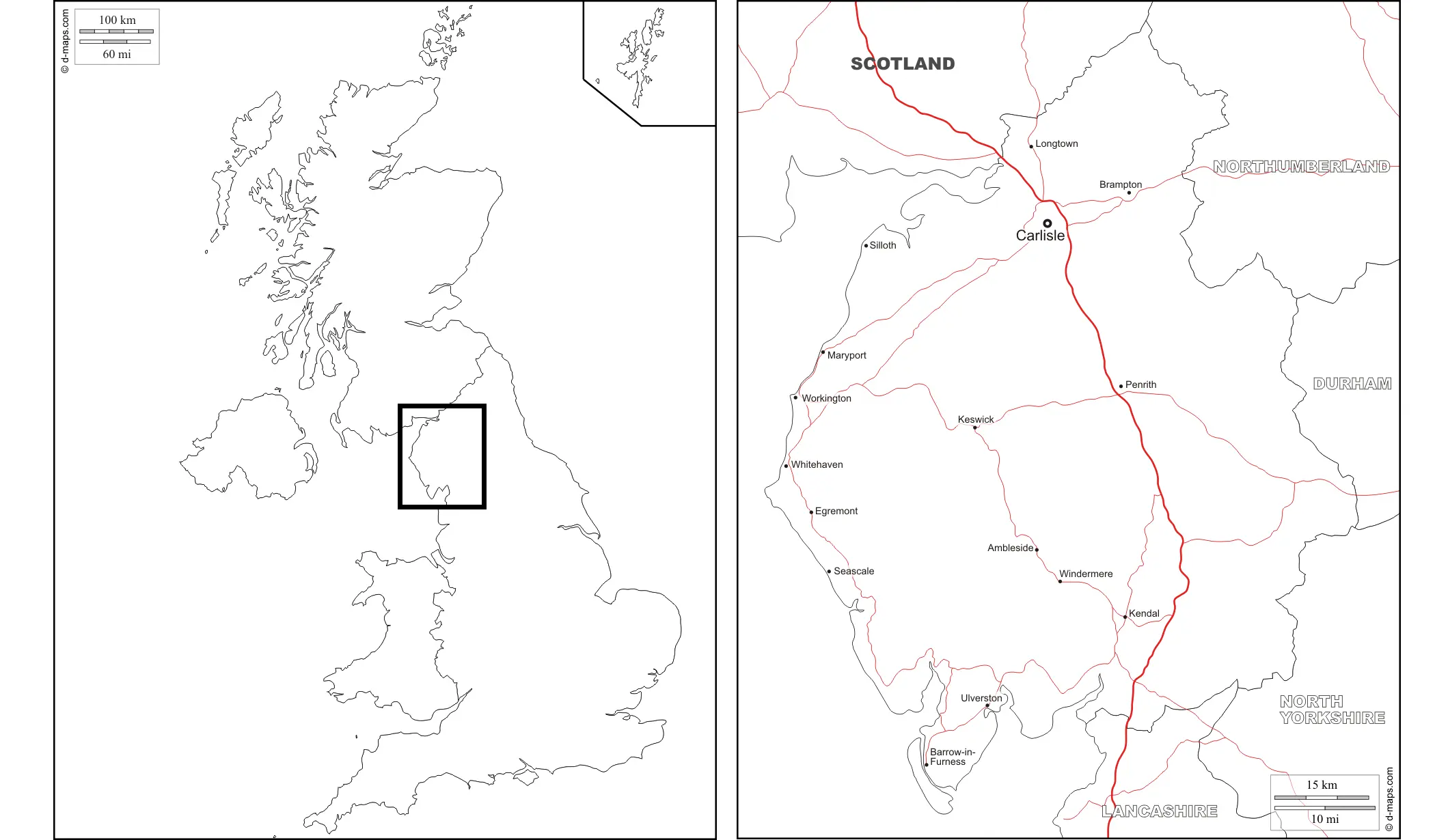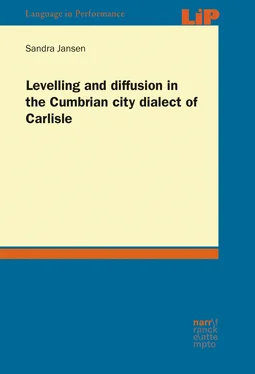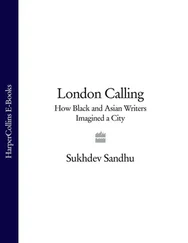Carlisle is also known as the Border City . This title reflects its proximity to the Scottish border which is only 16km away. Because of its geographical key position in Britain, Carlisle has always been important as a military defence point. While Newcastle was founded in the east to secure the area, Carlisle was seen as the equivalent in the west of the country. Map 3.1. shows Carlisle’s geographical location in England. London is about 500 km away which makes Carlisle the English city which is furthest away from London. This is an important point considering the diffusion of linguistic features which are associated with London English.
The city’s surrounding area is dominated by agriculture. The closest urban area is Tyneside, some 90km away to the east, accessible by rail and car. South-west of the city, about 50km from Carlisle, one finds the Lake District with its rugged landscape. To the east are the Pennines, which stretch across the country. They are not very high in the north-east, making travel to Newcastle relatively easy. The Borderlands, also known just as the Borders, as well as the area west of Carlisle out to the Irish Sea (West Cumbria) are sparsely populated areas. The setting of the Carlisle and its surroundings makes it interesting in terms of identity construction but also in terms of geolinguistic spread, i.e. levelling and diffusion of features.

Figure 3.1:The geographical position of Carlisle in Britain (d-maps.com)
Figure 3.1 provide a map of parts of the UK and Cumbria. Carlisle is connected with other regions by road and rail. The only motorway in Cumbria is the M6 which runs through the county on a north-south axis connecting Cumbria with Edinburgh/Glasgow to the north and Lancaster, Merseyside and Greater Manchester to the south. The city of Carlisle is found in close proximity to this motorway. In addition, the A595 and A596 coming from Whitehaven and Workington end in Carlisle and the A69 connects Carlisle with the north-east. Thus, Carlisle has good road infrastructure.
According to the 2011 census, Carlisle has a population of 104,500. The British Census data from 1831 to 2001 shows a gradual growth from around 40,000 in 1831 to around 100,000 in 1961. After this, the number of people levels at about 100,000 (www.visionofbritain.org.uk). The data in itself shows that there are no large groups suddenly swamping the city. Carlisle is a city with a long history which has not seen any drastic population changes in the last fifty years. However, even though the data paints a picture of gradual and at times stagnating population growth, there has of course been some movement. Out of the 40 participants in this study, 34 provide some information on the background of their parents. Either one or both parents of 26 people in the sample were not from Carlisle originally. This was also my general observation when I was trying to find speakers in Carlisle for my sample. In many cases, they were not originally from Carlisle but from surrounding areas and it was also not uncommon to meet people from further away, e.g. Malta, Australia, Middlesex and London. I also asked the people in which areas of the city they had lived. Most of them had moved within the city. Thus, one can assume that close-knit communities did not exist or were weakened by this inner-city movement.
The influx of people to Carlisle is not the whole story. Shepherd (2011) reports quite a large number of emigrants from Cumberland between 1815 and 1914. While she shows that many of the people who left the county were from more rural areas, there were also emigrants leaving Carlisle. Hence, while there was an influx of people from Scotland, Ireland and West Cumbria to Carlisle in the 19 thcentury, at the same time people were also leaving the city. Towns found overseas with names such as Carlisle in Cumberland County, Pennsylvania and Penrith in Australia are evidence for these emigration tendencies.
In terms of ethnic groups, the vast majority of the population (97.8%) was ‘White British’, a classification used in the 2001 census. 85.7% of the United Kingdom was classified as ‘white’. Carlisle is therefore one of the whitest places in England. However, since 2001 the city has seen an influx of various (white) ethnic groups. It is estimated that a population of around 1,600 Polish workers and 500 Portuguese workers live in Carlisle (Carlisle City Council Equality Impact Assessment: 6). Thus, ethnic minorities play a minor role in the population make-up of the city.
According to the 2001 census, 35.7% of the population belonged to the Middle Class (nationally: 48%). The comparatively low percentage of Middle Class people in Carlisle is likely to have two reasons. 1) The number of pupils who leave school without graduating is comparably high: 32% in Carlisle vs. 21% in Cumbria (Huntington and McKerr 2008: 2). 2) There is a lack of jobs for more highly qualified people. Even though Carlisle now has a university, it only offers a limited choice of degree courses. For this reason, many young people leave Carlisle to study elsewhere never to return because finding employment in Carlisle is difficult, especially in fields such as media, marketing, and academia.
The two main employment sectors are and have been factory work (manufacturing) and services. Agriculture does not play an important role anymore, at least not in the city.
The history of the city dates back to the Romans. They installed a military base, building a fort in the Carlisle area around 80 A.D. which they called Luguvalium (Smith 1984: 8). From this fort, the Romans unsuccessfully tried to conquer Scotland. When they realised that they could not defeat the Scots, one of the most important Roman sites, Hadrian’s Wall was built in 122 A.D “to keep out the barbarians” ( http://www.hadrians-wall.info/). The power vacuum left by the Romans was filled with bloody conflict between different Celtic tribes. This period of instability finds its climax in the raids of the Danes (Smith 1984).
Up until these Viking raids the area was Celtic-speaking. Only after the Viking invasion did English become the language spoken in this area (Smith 1984).
Carlisle only slowly recovered from the Scandinavian incursions. When William II came to Carlisle in 1092 his goal was to restore the town and build a castle in order to secure the frontier between England and Scotland. During the following centuries, Carlisle was often under siege and was torn between England and Scotland. Because of its ideal position as a military stronghold, both countries made demands on it.
Towill (1996: 137) summarises the situation of Carlisle in the middle of the 18 thcentury, after the last siege, as follows:
Carlisle in 1745 was a beleaguered fortified city, a city with a self-centred unspecialised economy with citizens providing for their own needs and making their own clothes, and an isolated city with minimal communication with the rest of the country.
From the mid-18 thcentury onwards the situation changed and Carlisle became less isolated, gaining importance as a communication centre in particular for the military. To make travel between Carlisle and Newcastle easier, a road was built along Hadrian’s Wall.
In 1759 a visitor described Carlisle as “a small deserted dirty city; poorly built, and poorly inhabited. The Cathedral is miserably ragged and dirty inside and out” (quoted in Smith 1984: 85). At this time about 2,000 people lived in the town, but by 1763 this number had increased to about 4,150. The years up to the turn of the century saw a vast number of arrivals from Cumberland, Scotland and Ireland. In 1801, the city had as many as 33,000 inhabitants and this number doubles by 1901, reaching 75,000 ( www.visionofbritain.co.org).
Читать дальше












